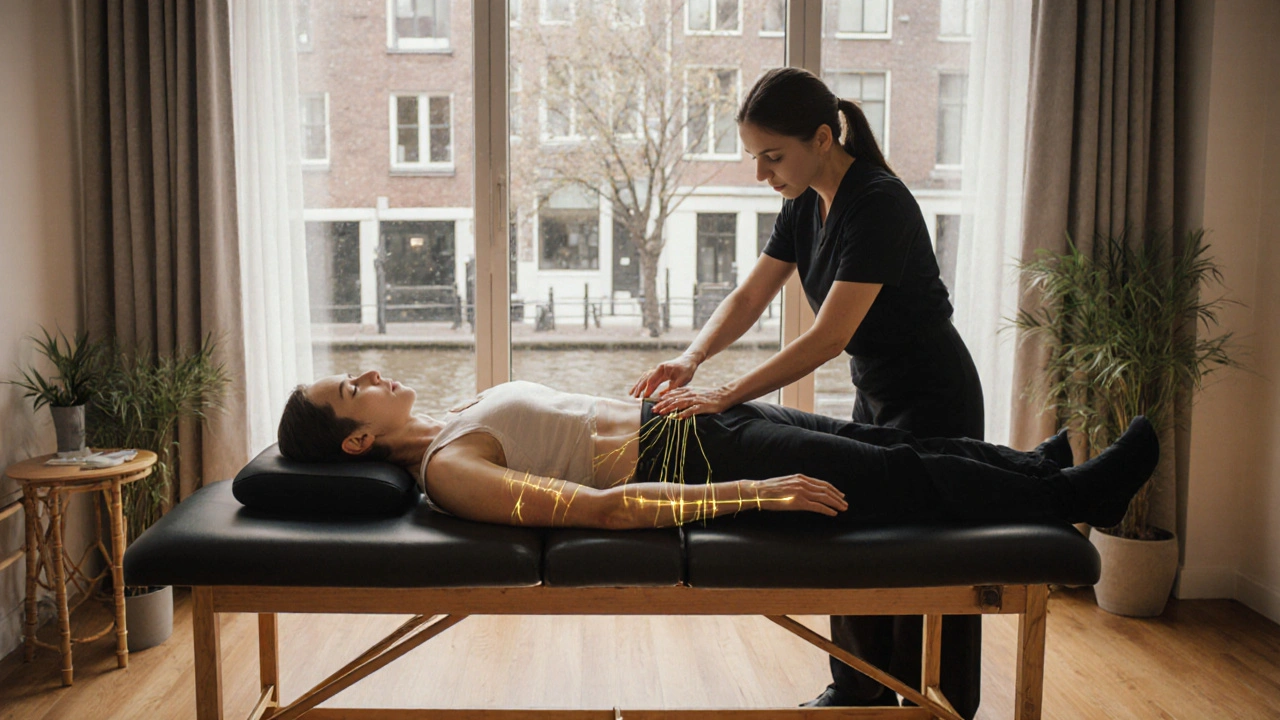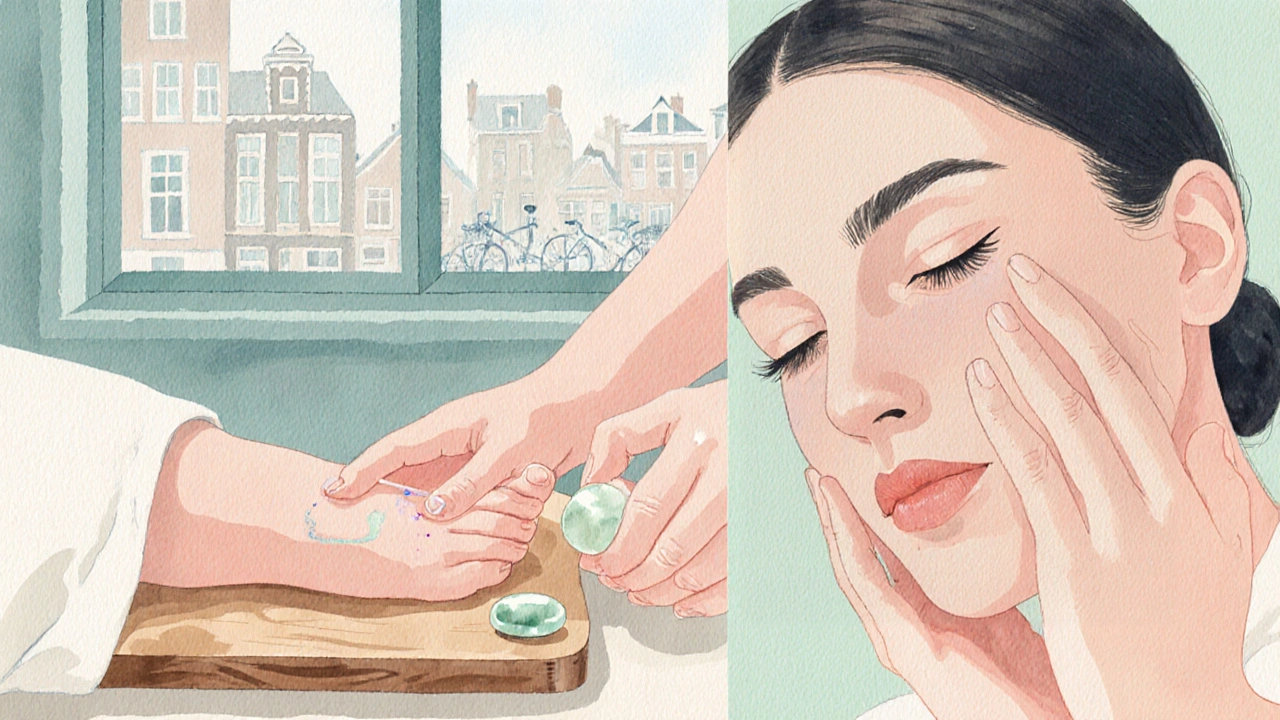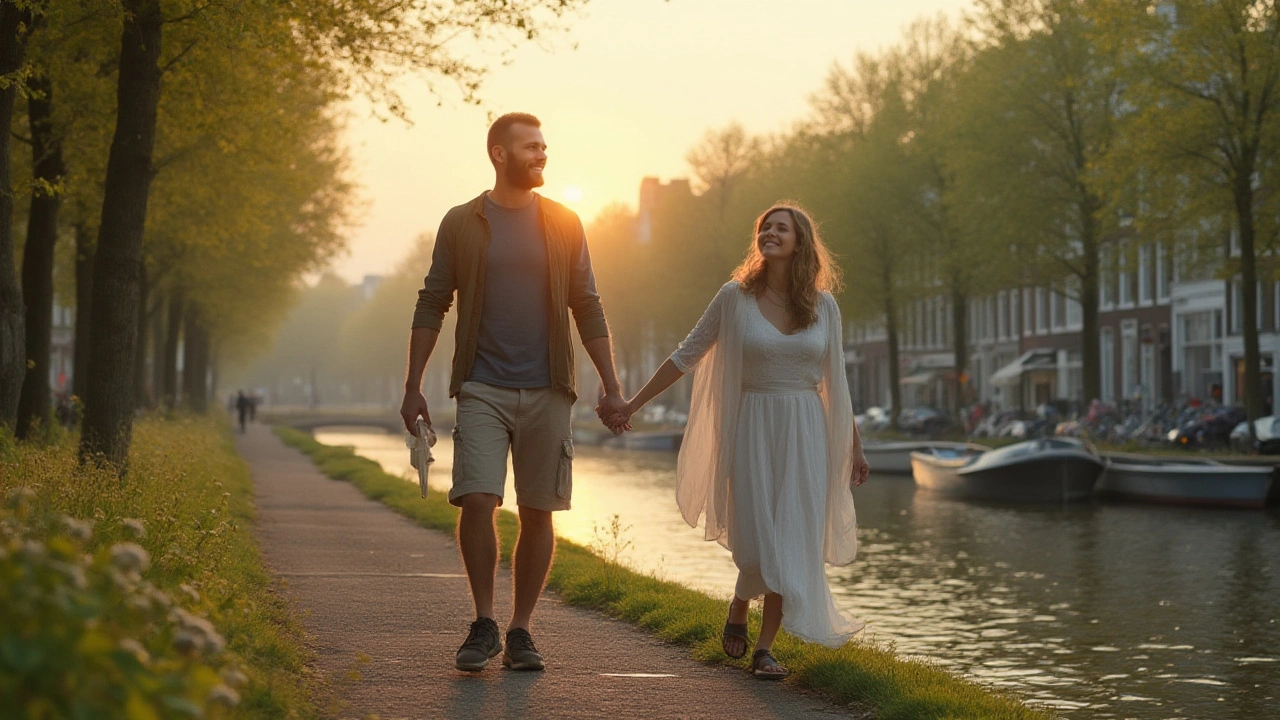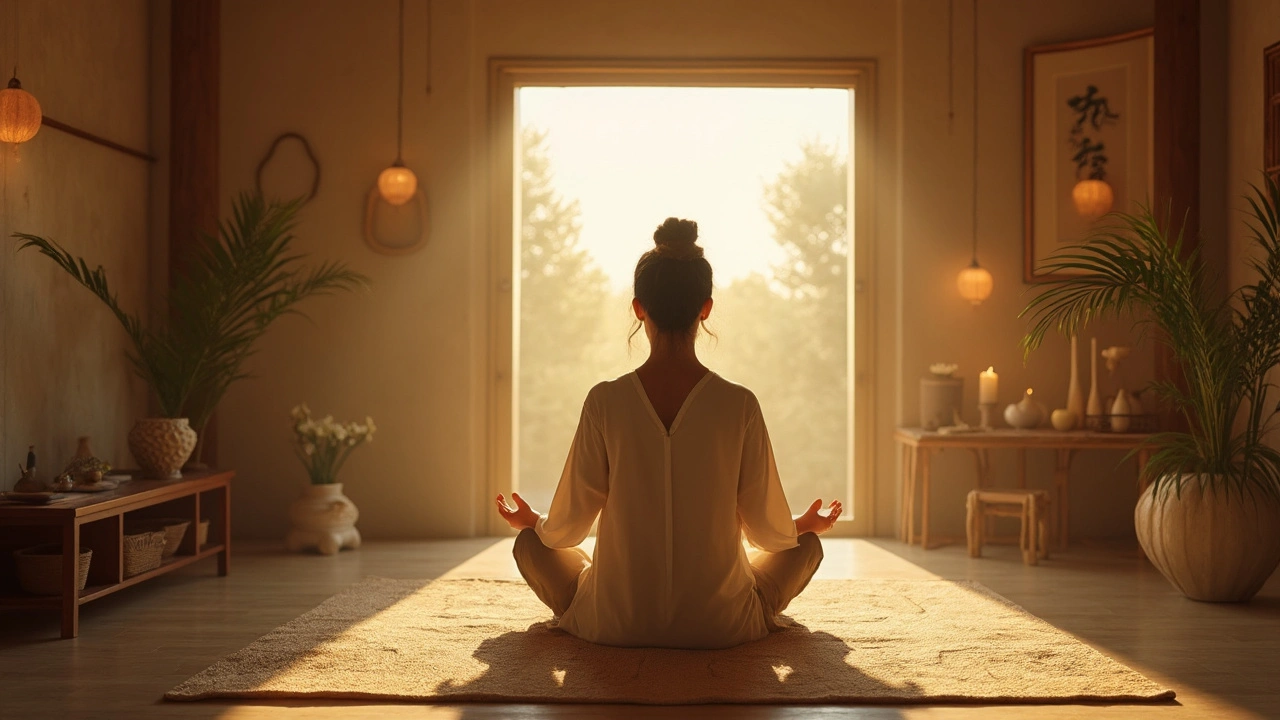Tuina Massage: How This Chinese Therapy Boosts Health in Amsterdam

Key Takeaways
- Tuina massage is a hands‑on Chinese therapy that balances Qi through pressure on meridians.
- It can relieve chronic pain, improve circulation, and reduce stress without needles.
- Amsterdam hosts several certified practitioners offering body‑work, foot‑focused, and facial Tuina.
- Typical sessions cost €70‑€120 and last 60‑90 minutes.
- Contraindications include recent fractures, severe varicose veins, and uncontrolled hypertension.
Quick Answer
Tuina massage is a Traditional Chinese Medicine technique that uses finger pressure, stretching, and joint mobilization to stimulate energy pathways (meridians) and promote healing. In Amsterdam you can book a 60‑minute session for around €90, expect a thorough body assessment, and walk away feeling looser, calmer, and more energetic.
What Is Tuina Massage?
When you hear Tuina massage, you might picture exotic needles or herbal teas. In reality, it’s a full‑body, hands‑only therapy that originated over 2,000 years ago.
Tuina massage is a manual therapy rooted in Traditional Chinese Medicine that aims to balance the body’s vital energy, or Qi, by applying pressure to specific points along the meridians. Practitioners blend acupressure, deep‑tissue strokes, and gentle joint rocking to restore flow and relieve tension.
Unlike Western styles that focus mainly on muscle knots, Tuina looks at the entire energetic network, treating the root cause rather than just the symptom.
How Tuina Works: Qi, Meridians, and Pressure
Qi is the vital life force that circulates through invisible pathways called meridians. When Qi becomes stagnant or deficient, pain, fatigue, or digestive issues can appear.
Tuina practitioners locate meridian points using their fingertips, thumb pads, or knuckles. By pressing, kneading, or tapping these points, they stimulate the flow of Qi, much like a river being cleared of debris.
Many clients notice an immediate sense of warmth or tingling during treatment - a sign that the energetic circuit is re‑opened.
Benefits of Tuina Massage
Because Tuina addresses both physical and energetic layers, its benefits are wide‑ranging:
- Pain relief: Chronic back, neck, and joint pain often improve after 2-3 sessions.
- Stress reduction: The deep, rhythmic strokes trigger the parasympathetic nervous system, lowering cortisol.
- Improved circulation: Gentle rocking and stretching encourage blood and lymph flow, reducing swelling.
- Enhanced flexibility: Joint mobilizations increase range of motion without aggressive stretching.
- Digestive support: Balancing the Spleen and Stomach meridians can ease bloating and irregularity.
Real‑world example: Marieke, a 38‑year‑old graphic designer from De Pijp, says her migraine frequency dropped from weekly to monthly after four Tuina sessions.

Types of Tuina Available in Amsterdam
Amsterdam’s multicultural scene means you’ll find several Tuina approaches:
- Full‑body Tuina: Classic routine covering back, limbs, abdomen, and head.
- Foot Tuina: Focuses on reflex points on the soles, great for athletes.
- Facial Tuina: Gentle lifts and pressure points that improve skin tone and reduce sinus tension.
- Gua Sha‑enhanced Tuina: Uses a smooth jade tool to scrape the skin, boosting micro‑circulation.
Most therapists bundle a short consultation, 60‑minute treatment, and after‑care advice.
Finding a Qualified Tuina Therapist in Amsterdam
Here’s a quick checklist to spot a reputable practitioner:
- Verify certification from a recognized Chinese Medicine school (e.g., Shanghai University of Traditional Chinese Medicine).
- Look for a clean, private treatment room - the environment matters for relaxation.
- Read client reviews that mention hygiene, professionalism, and clear communication.
- Ask whether the therapist integrates acupressure into the session. A good sign of holistic training.
- Confirm insurance compatibility if you plan to claim reimbursement.
Neighborhoods like De Wallen, Oud‑Zuid, and the Jordaan host several clinics. A simple Google search for “Tuina therapist Amsterdam” plus the district name will pull up maps and contact details.
What to Expect During a Session
First, your therapist will ask about medical history, current symptoms, and lifestyle. This brief interview helps them tailor the pressure and meridian selection.
Next, you’ll lie on a comfortable massage table, fully clothed. Unlike many Western massages, there’s no need to undress - the therapist works over the clothing, adjusting pressure to your comfort level.
The treatment typically follows this flow:
- Warm-up - gentle palm strokes to relax the muscles.
- Meridian work - firm pressure on points along the Lung, Liver, and Kidney channels.
- Joint mobilization - subtle rocking of shoulders, hips, and knees.
- Closing - light tapping to seal the energy flow, followed by a short period of rest.
You may feel a mild ache at certain points, similar to a deep tissue massage, but it should never be painful.
Pricing and Booking
In Amsterdam, a 60‑minute Tuina session averages €90, while a 90‑minute session can run €120‑€150. Some studios offer package discounts (e.g., 5 sessions for €425).
Booking steps:
- Visit the clinic’s website or call the front desk.
- Provide a brief health summary and preferred time slot.
- Confirm the price and cancellation policy (most places require 24‑hour notice).
- Arrive 10 minutes early to fill out a consent form.
Many therapists accept debit, credit, or iDEAL - the Dutch favorite.
Safety Tips and Contraindications
Tuina is gentle, but a few precautions keep it safe:
- Avoid strong pressure if you have fresh bruises, open wounds, or severe skin conditions.
- People with uncontrolled high blood pressure should discuss modifications with the therapist.
- Recent surgeries, especially abdominal or spinal, require a medical clearance.
- Pregnant clients can still enjoy Tuina, but the practitioner will avoid certain meridians and use lighter pressure.
- Stay hydrated after the session; it helps flush out metabolic waste released during the treatment.
Tuina Massage vs. Swedish Massage in Amsterdam
| Aspect | Tuina Massage | Swedish Massage |
|---|---|---|
| Core Philosophy | Balances Qi via meridian pressure (Traditional Chinese Medicine) | Relaxation through long, gliding strokes (Western biomechanics) |
| Typical Session Length | 60-90 minutes | 60-120 minutes |
| Clothing Requirement | Fully clothed - therapist works over garments | Usually requires partial undress; draped with sheet |
| Primary Benefits | Energetic balance, pain relief, improved organ function | Stress reduction, muscle tension release, circulation boost |
| Typical Cost (Amsterdam) | €70‑€120 per hour | €80‑€130 per hour |
| Contraindications | Recent fractures, uncontrolled hypertension, severe varicose veins | Open wounds, acute inflammation, deep vein thrombosis |
Frequently Asked Questions
Frequently Asked Questions
How often should I get a Tuina massage?
For chronic issues, weekly sessions for the first month work well, followed by a maintenance schedule of once every two to four weeks. Acute pain may need two sessions per week until symptoms improve.
Do I need to be naked?
No. Tuina is performed over clothing, which many clients appreciate for comfort and modesty.
Can Tuina help with anxiety?
Yes. By calming the nervous system and promoting balanced Qi, many people report reduced worry and better sleep after regular treatments.
Is Tuina covered by Dutch health insurance?
Some supplementary policies reimburse alternative therapies if the practitioner is registered with the Dutch Association of Traditional Chinese Medicine. Check your policy details.
What should I do after a session?
Drink water, avoid heavy meals for an hour, and give your body time to integrate the energy shift. Gentle stretching or a short walk can enhance the benefits.
Ready to Experience the Difference?
If you’ve been curious about how an ancient Chinese technique can fit into your modern, busy life, now’s the perfect time. Search “Tuina therapist Amsterdam” and book a session that matches your schedule. A calmer, more flexible you could be just one appointment away.



Joshua Bastow
October 9, 2025 AT 15:03It is commendable that the author has undertaken the considerable task of summarizing a relatively niche modality such as Tuina massage for an Anglophone audience residing in Amsterdam.
Nevertheless, the exposition suffers from a cascade of structural redundancies that betray a lack of editorial rigor.
The repeated enumeration of meridian pathways, for instance, offers little beyond what is already expounded in the introductory paragraph, thereby inflating the word count without substantive augmentation.
Moreover, the juxtaposition of cost ranges alongside an ostensibly exhaustive list of contraindications results in a disjointed narrative flow that hampers reader comprehension.
A more judicious allocation of space to evidence‑based outcomes, perhaps citing peer‑reviewed studies concerning analgesic efficacy, would have endowed the piece with an empirical backbone.
The reliance on anecdotal testimonials, such as the case of a graphic designer experiencing reduced migraine frequency, although engaging, remains insufficient to substantiate the broader therapeutic claims.
In addition, the article neglects to address the regulatory landscape governing Traditional Chinese Medicine practitioners in the Netherlands, an omission that could mislead prospective clients regarding licensure requirements.
The inclusion of a comparative table, while visually appealing, suffers from typographical inconsistencies, notably the errant use of non‑breaking spaces that distort column alignment.
Whilst the author correctly identifies the necessity of consulting a qualified practitioner, the checklist could be enhanced by specifying requisite credentials, such as registration with the Dutch Association of Traditional Chinese Medicine.
The discussion of post‑session recommendations, limited to hydration and gentle movement, would benefit from a more comprehensive after‑care protocol, incorporating guidance on sleep hygiene and dietary considerations.
Furthermore, the brief mention of insurance reimbursement lacks nuance; a delineation of which supplemental policies typically extend coverage would have been advantageous.
From a linguistic standpoint, the piece oscillates between colloquial and pedantic diction, creating an incongruous tonal palette that may alienate both lay readers and seasoned practitioners alike.
The integration of foot‑focused and facial Tuina modalities is addressed superficially, lacking a discussion of the underlying physiological mechanisms that differentiate these techniques.
In sum, the article presents a foundational overview of Tuina massage within the Dutch context, yet it is encumbered by excess verbiage, insufficient scholarly attribution, and occasional editorial oversights.
A revision that streamlines repetitive content, augments empirical support, and adheres to consistent stylistic conventions would markedly elevate its informational value.
Danielle Yao
October 9, 2025 AT 15:53I noticed a few minor punctuation errors in the article, such as missing commas after introductory phrases.
Rehan Rasheed
October 9, 2025 AT 17:00Yo, if you’re on the fence about trying Tuina, just go for it – the energy vibes are real and you’ll walk out feeling like you’ve rebooted your system.
Even a single session can loosen up that stiff neck you’ve been ignoring, and the after‑care tip to stay hydrated is a game‑changer for flushing out the loosened tension.
Plus, Amsterdam’s diverse clinics mean you can pick a therapist whose style clicks with you, whether you prefer a full‑body flow or a quick foot‑focused fix.
Give it a shot, and you might end up swapping that caffeine binge for a calmer, more balanced hustle.
Caleb Wingate
October 9, 2025 AT 17:50Honestly, I was skeptical at first, but after my first Tuina session I could actually feel my lower back loosen up in a way no ordinary massage ever did.
I told the therapist about my recent car accident, and they adjusted the pressure – it felt a bit invasive, but the relief was undeniable.
If you’ve got chronic tension, just let them know your exact pain spots and they’ll target the meridians that actually matter.
Robert Stoots
October 9, 2025 AT 19:13Great points raised earlier! I’d add that many practitioners in Amsterdam are actually members of recognised Dutch TCM bodies – this stamp of approval really matters!!
Also, don’t overlook the simple fact that a clear, uncluttered treatment space can boost the whole experience; a tidy room equals a tidy mind!!
While some may say the table of costs is enough, it’s also useful to know that many clinics offer sliding‑scale packages for students – a win‑win!!
Finally, remember to breathe deeply during the session; the rhythmic strokes work best when your own Qi is already calm!!
All in all, stay open, ask questions, and enjoy the holistic benefits.
Ross Silvis
October 9, 2025 AT 20:36Oh sure, because a 90‑euro massage will magically fix everything – that’s totally realistic.
Maybe try a home remedy before splurging on fancy meridian pressure.